El Yunque National Forest
- December 29, 2023
- 0 comment
El Yunque National Forest is an absolutely stunning rainforest located in northeastern Puerto Rico that you just have to see! It’s the only rainforest in the U.S. National Forest System and covers over 28,000 acres of lush terrain on the slopes of the Sierra de Luquillo mountains. The forest is home to all kinds of cool plants and animals, like towering Sierra palm trees and adorable Puerto Rican parrots.
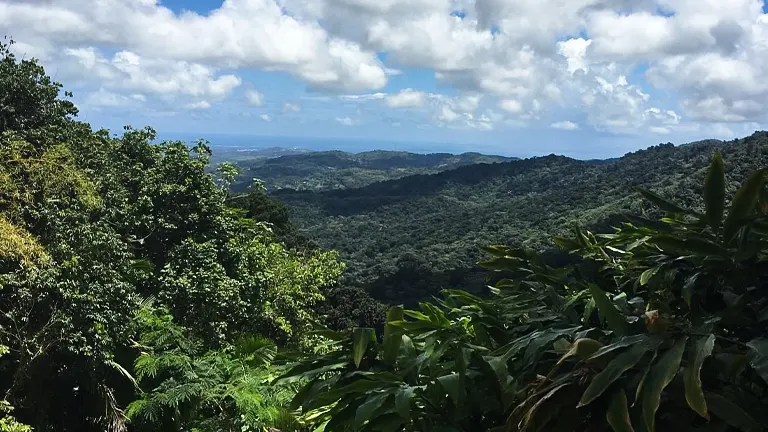
Whether you’re a nature enthusiast or an adventure seeker, El Yunque has so much to offer! There are tons of trails to explore, cascading waterfalls to discover, and panoramic vistas to take in, all inviting you to dive deep into the heart of this extraordinary rainforest. And the forest’s rich history is fascinating, dating back to the Spanish Crown’s efforts to preserve this unique ecosystem. El Yunque is truly a tropical paradise and a testament to Puerto Rico’s commitment to conservation.
Today, El Yunque National Forest continues to delight and inspire visitors from all over the world. It’s the perfect place to escape and immerse yourself in nature’s beauty. So come and see it for yourself – you won’t be disappointed!
Characterizing Features of the El Yunque National Forest
- Unique Ecosystems: El Yunque National Forest is renowned for its diverse ecosystems, each contributing to its unparalleled biodiversity. From the towering Sierra palm tree forest to the ancient Palo Colorado forest, the varied landscapes create a habitat for a rich array of plant and animal species. The Tabonuco forest, with over 170 tree species, and the mystical Dwarf forest at higher elevations add to the ecological tapestry, making El Yunque a living laboratory of natural wonders.
- Distinctive Peaks: Dominating the forest’s skyline are prominent peaks, such as Pico El Yunque, reaching an elevation of 3,494 feet above sea level. Each peak, including Pico del Este, Pico del Oeste, El Cacique, and El Toro, contributes to the dramatic topography of the rainforest. These heights not only provide breathtaking panoramic views but also shape the microclimates and habitats within the forest.
- Abundant Rainfall: El Yunque’s climate is characterized by its tropical rainforest setting, receiving over 20 feet of rainfall in some areas annually. This consistent precipitation fosters a jungle-like environment with lush foliage, cascading waterfalls, and meandering rivers. The ample water supply sustains the diverse flora and fauna, creating a haven for species adapted to the region’s unique climatic conditions.
- Historical Significance: Beyond its natural beauty, El Yunque holds historical significance, dating back to the pre-Columbian era. Archaeological sites, such as the Río Blanco petroglyphs, bear witness to the forest’s connection with the indigenous Taíno people. The forest’s name, whether inspired by the Spanish word “yunque” or native names like Yukén or Yuke, adds cultural depth, hinting at its place in both colonial and indigenous narratives.
- Resilience Amid Challenges: El Yunque has faced various challenges throughout its history, including gold mining during the Spanish conquest, military installations during wartime, and the impacts of hurricanes such as Hugo and Maria. Despite these challenges, the forest stands resilient, a testament to its enduring spirit and the conservation efforts that have shaped its history. This resilience reinforces El Yunque as a symbol of Puerto Rico’s commitment to preserving its natural heritage.
- Recreational Opportunities: The forest not only captivates with its natural features but also offers a plethora of recreational opportunities. Hiking trails wind through its landscapes, providing access to waterfalls, viewpoints, and diverse ecosystems. Visitors can explore the Yokahú Observation Tower for expansive views, engage in adventure activities like ziplining, or simply immerse themselves in the tranquility of this tropical haven. El Yunque is not merely a static landscape but an interactive and dynamic destination for nature enthusiasts.
- Conservation Legacy: El Yunque’s conservation legacy dates back to the Spanish Crown’s efforts in 1876 to preserve its soil, water resources, and timber industry. Designated as a National Forest in 1906, it became the Caribbean National Forest in 1935 and was later renamed El Yunque National Forest in 2007. The forest continues to play a crucial role in conservation, housing the El Verde Field Station for scientific research and standing as a testament to Puerto Rico’s commitment to protecting its natural treasures.
History
Located in the northeastern corner of Puerto Rico, El Yunque National Forest boasts a rich history that spans centuries. The region was notable in the pre-Columbian era, hosting archaeological sites like the Río Blanco petroglyphs, suggesting a connection with the indigenous Taíno people. The Spanish conquest in 1493 brought gold mining to the Fajardo and Blanco Rivers, impacting the area until 1530 when Taíno resistance led to its abandonment. The 19th century saw the exploitation of lowland forests for agriculture, drawing the attention of the Spanish Crown. In 1876, King Alfonso XII set aside the region to preserve soil, and water, and regulate timber.
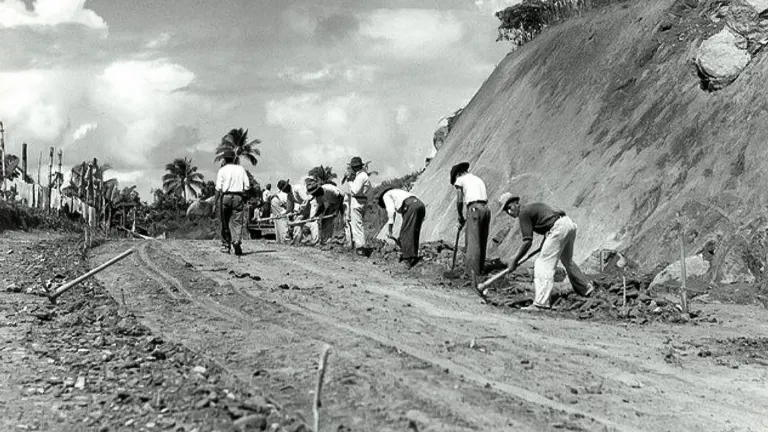
When Puerto Rico became a U.S. territory in 1898, El Yunque was part of the Crown Lands, preserved amid widespread deforestation. Designated a National Forest in 1906 and named the Caribbean National Forest in 1935, it weathered challenges during World Wars and became a hub for scientific research. In 2007, reflecting cultural sentiments, it was renamed El Yunque National Forest, standing today as a testament to Puerto Rico’s commitment to conservation and natural heritage.
Importance in Conservation and Recreation of El Yunque National Forest
El Yunque National Forest stands as a dual beacon of significance, seamlessly blending conservation and recreation. Recognized for its crucial role in biodiversity, the forest serves as a sanctuary for over 200 species of trees and plants, with 16 endemic to its lush landscapes. The critically endangered Puerto Rican parrot finds refuge here, alongside other rare species such as the Puerto Rican broad-winged hawk and the Elfin woods warbler. The forest’s ecological importance extends to its arthropod population, a vital component of the intricate food web. Amidst the challenges posed by climate change, El Yunque persists as a resilient haven, fostering conservation efforts to protect its delicate ecosystems.
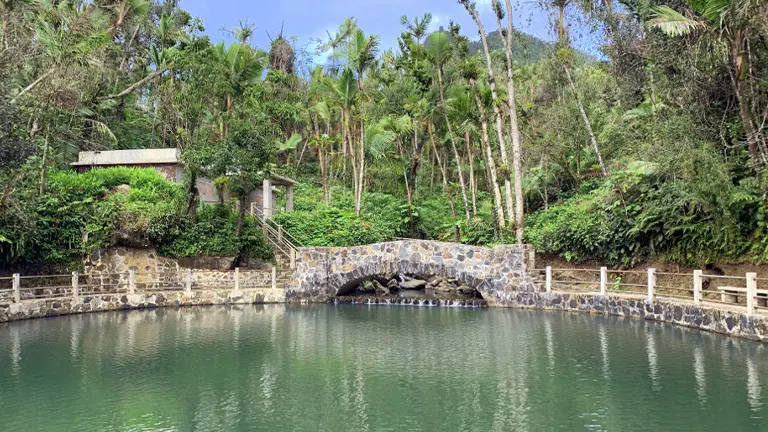
Beyond its ecological contributions, El Yunque is a haven for outdoor enthusiasts and curious minds. Popular as a recreational hub, the forest offers a myriad of activities, from hiking its diverse trails to marveling at its scenic vistas from observation towers like Yokahu and Mount Britton. The forest’s commitment to education is evident in designated research areas like the Baño de Oro Natural Area, fostering scientific study and future conservation endeavors. As one of the most visited attractions in Puerto Rico, El Yunque not only captivates with its natural beauty but also serves as a crucial tool in environmental education and awareness, highlighting the delicate balance between human enjoyment and the preservation of a precious ecological gem.
As one of Puerto Rico’s most beloved natural treasures, El Yunque National Forest has captured the hearts and imaginations of countless visitors over the years. Whether you’re seeking adventure, relaxation, or simply a chance to reconnect with nature, this magnificent rainforest offers something for everyone. So why not plan your own visit to El Yunque and discover the magic of this truly special place for yourself?
Unique Location of El Yunque National Forest
Located in the northeastern corner of the enchanting island of Puerto Rico, El Yunque National Forest occupies a place of pride and natural wonder. Perched on the slopes of the Sierra de Luquillo mountains, this tropical paradise covers more than 28,000 acres, making it the largest block of public land in Puerto Rico. Its geographical embrace spans across the municipalities of Río Grande, Luquillo, Naguabo, Ceiba, Fajardo, Canóvanas, and Las Piedras.
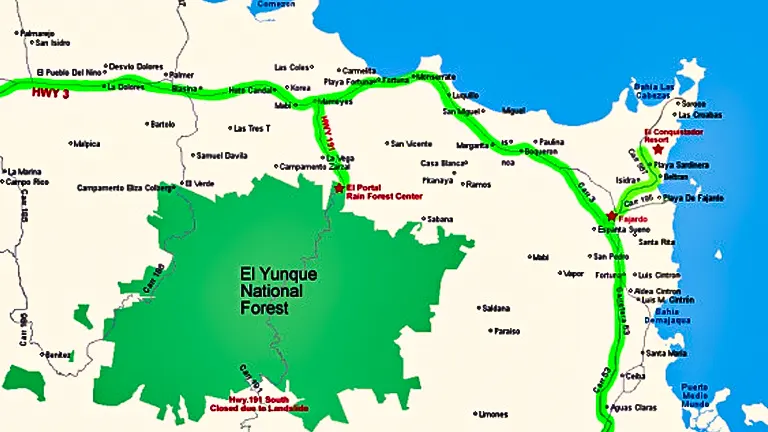
As the only tropical rainforest in the U.S. National Forest System, El Yunque boasts an elevation that peaks at 3,494 feet above sea level. Enveloped in the embrace of abundant rainfall, with some areas receiving over 20 feet annually, the forest creates a jungle-like setting adorned with lush foliage, waterfalls, and rivers, inviting visitors to immerse themselves in its captivating beauty and rich biodiversity.
Diverse Vegetation and Unique Plant Species
- Tabonuco Tree (Dacryodes excelsa): The Tabonuco Forest, dominated by the Tabonuco tree (Dacryodes excelsa), showcases a rich tapestry of flora. Endemic species like the endangered laurel magnolia (Magnolia splendens) thrive in this ecosystem, contributing to its biodiversity and ecological importance.
- Palo Colorado Tree (Cyrilla racemiflora): Above 2,500 feet, the Palo Colorado Forest features the distinctive palo colorado tree (Cyrilla racemiflora), recognized by its red crooked bark. Some of these ancient trees, estimated to be up to 1,000 years old, provide habitat for the endangered Puerto Rican parrot.
- Sierra Palm Tree (Prestoea montana): At 1,970 feet, the Sierra Palm Tree Forest is dominated by the Sierra palm tree (Prestoea montana). Thriving in the shallow soil at this altitude, this species illustrates the adaptability of plant life to specific environmental conditions within the forest.
- Dwarf Forest (Cloud Forest): The Dwarf Forest, situated around 3,000 feet, boasts stunted tree growth and unique vegetation. Species like Ocotea spathulata, Tabebuia rigida, Calyptranthes krugii, Eugenia borinquensis, and Calycogonium squamulosum are well-suited to the high acidity and poor water runoff characteristic of this sub-region.
- Baño de Oro Natural Area: As part of the Research Natural Area and National Natural Landmark, Baño de Oro, with its elevations between 800 and 3,365 feet, serves as a sanctuary for scientific study. Notable species include those found in a rare Pterocarpus swamp, contributing to the preservation of diverse forest types.

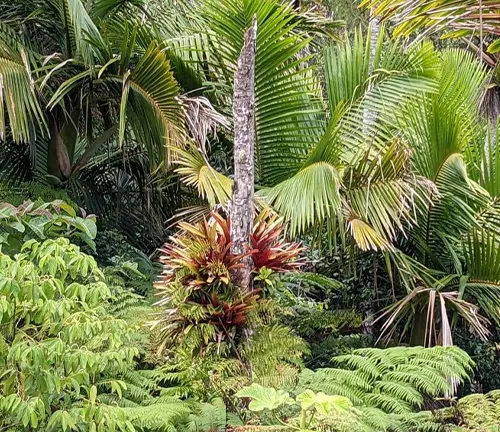
Different Species of Mushrooms in El Yunque National Forest
- Prince Mushroom (Agaricus augustus) – commonly known as the prince mushroom, is a large edible mushroom that grows in the forest during the rainy season. It is known for its distinctive sweet almond-like aroma.
- Fly Agaric (Amanita muscaria) – also known as the fly agaric, is a poisonous mushroom that is commonly found in the forest. It has a bright red cap with white spots and is used in shamanic rituals by some indigenous communities.
- Artist’s Conk (Ganoderma applanatum) – commonly known as the artist’s conk, is a bracket fungus that grows on living or dead trees. It has a brownish top that can be used as a canvas for drawing.
- Oyster Mushroom (Pleurotus ostreatus) – commonly known as the oyster mushroom, is a widely cultivated edible mushroom that grows on dead hardwood trees in the forest.
- Chicken of the Woods (Laetiporus sulphureus) – commonly known as the chicken of the woods, is an edible fungus that grows on living or dead trees. It has a bright yellow-orange color and is a popular ingredient in vegetarian cooking.
Fauna
- Puerto Rican Parrot (Amazona vittata): The Puerto Rican Parrot, scientifically known as Amazona vittata, is a critically endangered species and the only remaining native parrot in Puerto Rico. El Yunque National Forest provides a crucial habitat for this vibrant green parrot with a red forehead.
- Puerto Rican Broad-winged Hawk (Buteo platypterus brunnescens): Endemic to Puerto Rico, the Puerto Rican Broad-winged Hawk (Buteo platypterus brunnescens) is another endangered species found in El Yunque. This hawk plays a vital role in the forest’s food web, contributing to the balance of predator-prey relationships.
- Puerto Rican Sharp-shinned Hawk (Accipiter striatus venator): The Puerto Rican Sharp-shinned Hawk (Accipiter striatus venator) is an endangered raptor species inhabiting El Yunque National Forest. Its presence underscores the forest’s significance as a haven for diverse bird species.
- Elfin Woods Warbler (Setophaga angelae): Endemic to Puerto Rico, the Elfin Woods Warbler (Setophaga angelae) is a rare and endangered bird species found in the forest. Its presence highlights the importance of El Yunque as a refuge for unique and threatened avian species.
- Puerto Rican Boa (Epicrates inornatus): The Puerto Rican Boa (Epicrates inornatus) is a non-venomous snake native to Puerto Rico, including El Yunque National Forest. This species plays a role in controlling rodent populations, contributing to the forest’s ecological balance.
- White-necked Crow (Corvus leucognaphalus): Once found in the region, the White-necked Crow (Corvus leucognaphalus) has been extirpated from Puerto Rico but was historically present. Its absence underscores the impact of environmental changes on wildlife populations.
- Dwarf Anole (Anolis occultus): The Dwarf Anole (Anolis occultus) is a small lizard species inhabiting the elfin woodlands of El Yunque. Adapted to the unique ecological conditions of the dwarf forest, this species is part of the diverse reptilian fauna in the area.
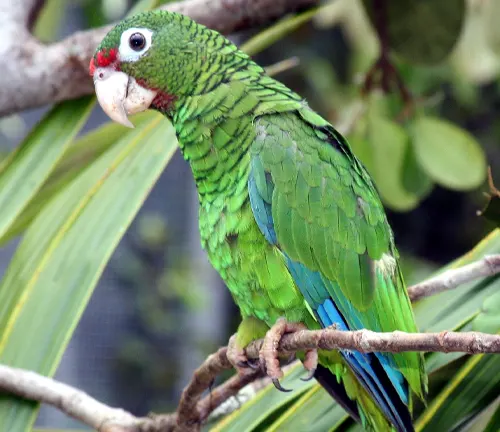
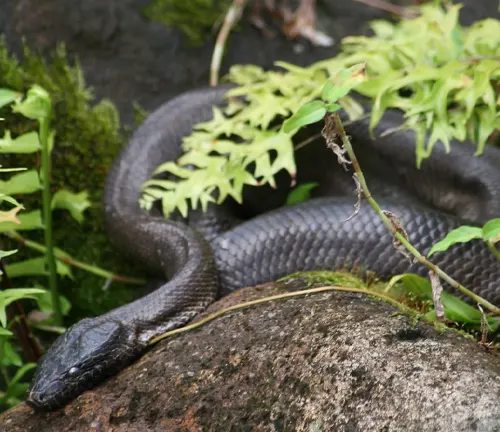
El Yunque National Forest boasts a rich diversity of fauna, including endangered and endemic species, emphasizing its significance in biodiversity conservation. The forest provides a habitat for these creatures and plays a crucial role in preserving Puerto Rico’s unique wildlife.
Importance as a Wildlife Corridor and Habitat for Threatened Species
El Yunque National Forest stands as a vital wildlife corridor and sanctuary, playing a pivotal role in the conservation of threatened species in Puerto Rico. Serving as a crucial link between fragmented habitats, the forest acts as a connective tissue for various ecosystems, facilitating the movement and dispersal of wildlife. Its expansive and diverse terrain, ranging from lowland areas to the towering peaks, provides a mosaic of habitats that accommodate a wide array of flora and fauna.

Particularly significant is its role in providing refuge for threatened species such as the critically endangered Puerto Rican Parrot, the elusive Elfin Woods Warbler, and the endemic Puerto Rican Boa. By serving as a haven for these species, El Yunque National Forest contributes significantly to global conservation efforts, emphasizing the importance of preserving such natural landscapes as integral components of broader ecological networks. The forest’s designation as a wildlife corridor underscores its function as a lifeline for biodiversity, promoting genetic diversity, and ensuring the long-term viability of Puerto Rico’s unique and endangered wildlife.
Activities in El Yunque National Forest for Visitors
1. Hiking Trails
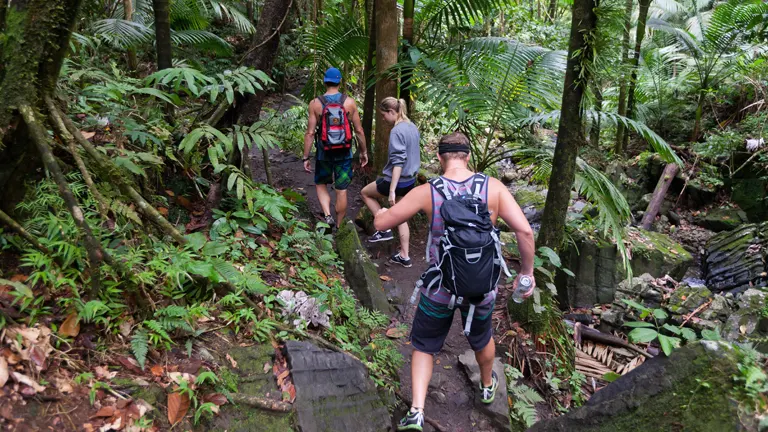
El Yunque National Forest offers a network of hiking trails catering to various skill levels, allowing visitors to immerse themselves in the breathtaking beauty of the rainforest. Trails like the iconic Pico El Yunque Trail lead adventurers through diverse ecosystems, providing encounters with unique plant and animal species. The trails are not only a feast for nature enthusiasts but also an opportunity to delve into the rich history and ecology of the region.
2. Ziplining Adventures
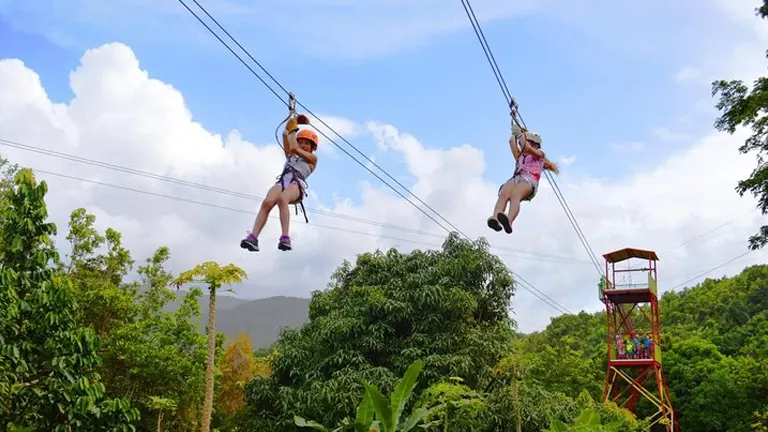
For those seeking an adrenaline rush, ziplining through the lush canopies of El Yunque presents an exhilarating experience. Canopy tours offer a bird’s-eye view of the forest, showcasing its expansive greenery and intricate topography. This adventure allows visitors to appreciate the rainforest from a different perspective, suspended above the forest floor.
3. Horseback Riding at Carabalí Rainforest Park
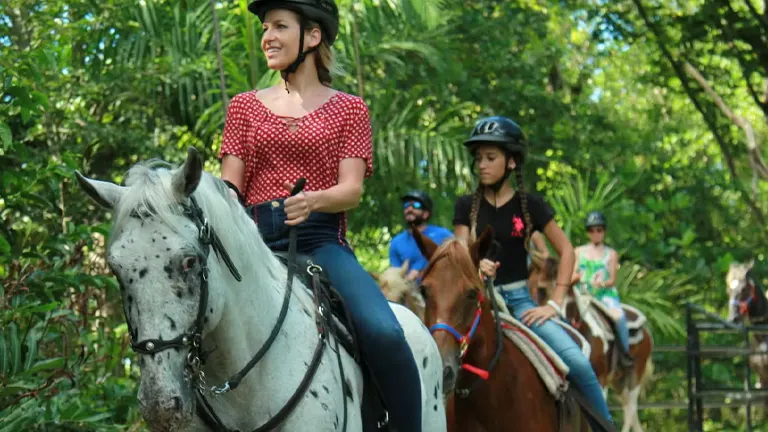
Carabalí Rainforest Park provides a unique way to explore El Yunque – on horseback. Guided horseback riding tours take visitors through scenic trails, offering a leisurely pace to absorb the natural wonders around. It’s a serene and immersive way to connect with the forest while enjoying the companionship of these gentle creatures.
4. Observation Towers
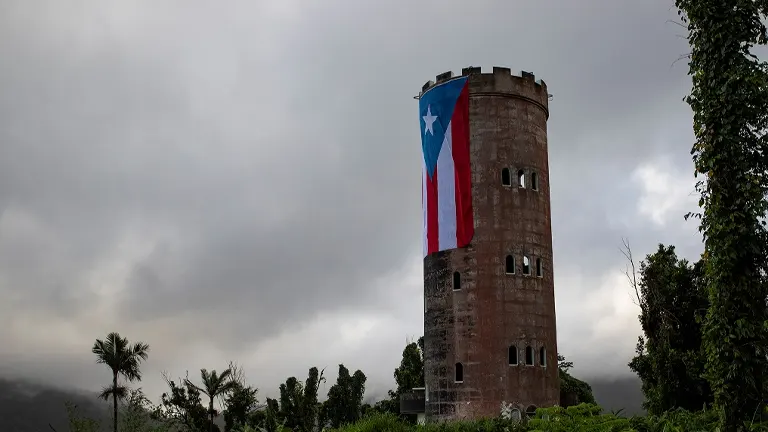
The Yokahú Observation Tower, perched at an elevation of 1,575 feet, stands as a testament to El Yunque’s grandeur. Climbing the tower rewards visitors with panoramic views of the surrounding mountains, providing a spectacular vantage point to appreciate the vastness and beauty of the rainforest landscape.
5. Swimming in Natural Pools

El Yunque National Forest boasts enchanting natural pools, such as those near La Mina Falls and the Juan Diego area. These pools offer a refreshing escape, inviting visitors to take a dip surrounded by the sights and sounds of the rainforest. Swimming in these natural oases provides a tranquil and rejuvenating experience.
6. Birdwatching
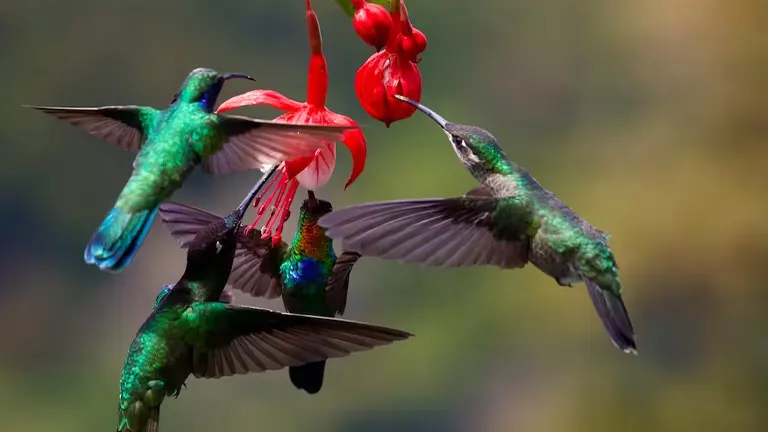
With over 200 species of trees and plants, El Yunque is a haven for birdwatchers. The forest is home to a variety of avian species, including the vibrant Puerto Rican parrot and the Elfin Woods Warbler. Birdwatching enthusiasts can explore the trails and observation points for glimpses of these feathered inhabitants.
7. Camping
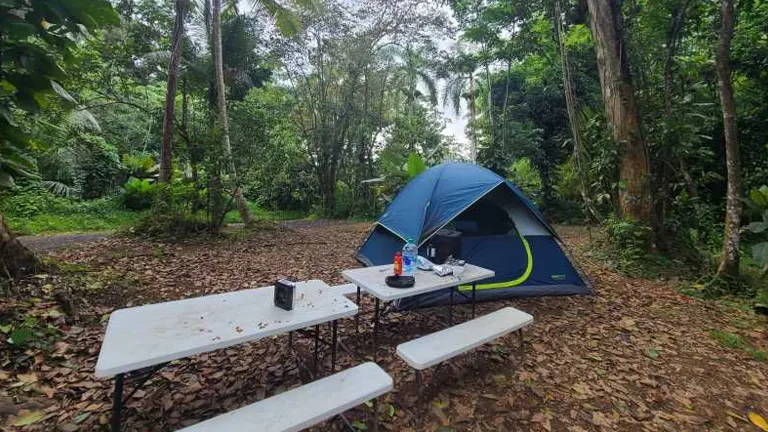
For those seeking a more immersive experience, camping is allowed in designated areas of the forest. Spending a night under the stars amidst the sounds of the rainforest provides a unique opportunity to connect with nature.
8. Educational Centers
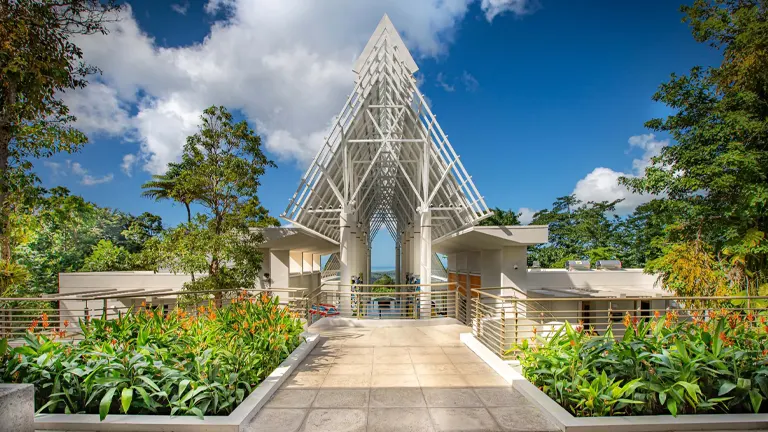
The forest features educational visitor centers like El Portal Rainforest Visitor Center, providing valuable insights into the ecology, history, and cultural significance of El Yunque. Interactive exhibits and knowledgeable staff enhance visitors’ understanding of the delicate balance maintained within this tropical ecosystem.
El Yunque National Forest caters to a wide range of interests, ensuring that visitors can engage with its natural wonders through various activities that blend adventure, education, and appreciation for the unique ecosystems it harbors.
Conservation and Management
- Research Natural Areas: El Yunque National Forest includes designated Research Natural Areas, such as the Baño de Oro Natural Area. These areas are set aside for scientific study, education, and conservation efforts. The 1,840-acre Baño de Oro area, established in 1949, focuses on preserving a forest section with minimal human disturbance, allowing for in-depth research and the protection of unique ecosystems.
- Endangered Species Protection: The forest plays a crucial role in protecting and rehabilitating endangered species. Notably, it is home to the critically endangered Puerto Rican Parrot, Puerto Rican Broad-winged Hawk, Puerto Rican Sharp-shinned Hawk, Elfin woods warbler, and Puerto Rican Boa. Conservation efforts target the enhancement of habitats and population management to ensure the survival of these species.
- Climate Change Studies: El Yunque serves as a living laboratory for climate change studies. Ongoing research, such as the 2018 study by Bradford C. Lister and Andres Garcia, monitors the impact of climate warming on arthropod biomass and its cascading effects on the forest ecosystem. This information contributes to global understanding and adaptation strategies.
- Forest Restoration Programs: The forest actively engages in restoration programs to recover areas impacted by natural events like hurricanes. For instance, post-Hurricane Maria, efforts have been directed toward replanting native vegetation, repairing trails, and restoring damaged habitats to maintain the forest’s resilience against environmental challenges.
- Visitor Education and Awareness: Management initiatives focus on educating visitors about the forest’s ecological significance and the importance of responsible tourism. Interpretive centers, educational programs, and signage inform the public about the delicate balance of the ecosystem, encouraging practices that minimize human impact.
- Water Resource Management: El Yunque is integral to Puerto Rico’s water supply, and sustainable water resource management is a priority. Preservation of water quality and quantity involves measures to prevent soil erosion, maintain healthy watersheds, and safeguard the forest’s role as a source of freshwater for the island.
- Invasive Species Control: Invasive plant and animal species pose a threat to the native biodiversity of El Yunque. Management strategies involve the control and eradication of invasive species to protect the integrity of the forest ecosystem and prevent the displacement of native flora and fauna.
- Collaboration with Local Communities: Conservation efforts extend beyond the forest boundaries, involving collaboration with local communities. Partnerships with residents and stakeholders contribute to sustainable practices, community engagement, and the shared responsibility of preserving this natural treasure.
- Monitoring and Research Programs: Continuous monitoring and research programs are in place to assess the health and dynamics of the forest ecosystem. Scientific studies help identify trends, understand ecological processes, and inform adaptive management strategies to address emerging challenges.
- Preservation of Cultural Heritage: Beyond ecological conservation, El Yunque National Forest preserves cultural heritage sites, such as the historic Baño Grande and Baño de Oro. These areas, though no longer used for swimming, are recognized as historic landmarks, showcasing the forest’s rich history and the importance of preserving both natural and cultural assets.
Recommendation
I strongly encourage you to discover the enchanting fusion of natural splendor and cultural importance within El Yunque National Forest. Celebrated for its varied ecosystems, iconic landmarks, and recreational possibilities, this forest provides a distinctive and immersive experience. Engage in contemplative outdoor pursuits like hiking and observing wildlife, actively participating in the continuous efforts for conservation. The picturesque trails, historical points of interest, and cooperative conservation initiatives position El Yunque National Forest as an essential destination for those desiring a seamless blend of nature and recreational discovery.
Conclusion
In conclusion, El Yunque National Forest stands as a testament to the captivating beauty and ecological richness that Puerto Rico has to offer. With its lush landscapes, diverse ecosystems, and historical significance, El Yunque provides a sanctuary for nature enthusiasts and a haven for numerous endemic species. The intertwining trails lead to breathtaking vistas, iconic landmarks, and unique plant and animal life, making every step a journey through a living tapestry of biodiversity. Beyond its natural allure, El Yunque serves as a vital conservation area, embodying the commitment to preserving the island’s environmental heritage. Whether one seeks adventure on its trails, solace in its serene landscapes, or a deeper understanding of Puerto Rico’s ecological tapestry, El Yunque National Forest invites all to immerse themselves in the wonders of this tropical paradise.
FAQs
- What makes El Yunque National Forest unique among other rainforests?
El Yunque National Forest is the only tropical rainforest within the U.S. National Forest System, offering a distinctive combination of lush biodiversity, rare ecosystems, and cultural significance in the Caribbean. - Why is El Yunque often referred to as a living laboratory?
El Yunque serves as a living laboratory due to ongoing scientific research and conservation efforts. Its diverse ecosystems provide valuable insights into tropical ecology, contributing to our understanding of biodiversity, climate patterns, and sustainable forest management. - What historical sites can visitors explore within El Yunque?
Visitors can explore historical sites such as Taíno petroglyphs, remnants of a coffee plantation at El Portal Rainforest Visitor Center, and landmarks dating back to the Spanish colonial era, reflecting the forest’s cultural and historical significance. - How does El Yunque contribute to conservation efforts?
El Yunque plays a crucial role in conservation by providing a protected habitat for endangered species like the Puerto Rican parrot and elfin woods warbler. Conservation programs and research within the forest actively contribute to preserving these threatened species. - What recreational activities are available for visitors at El Yunque?
El Yunque offers a range of recreational activities, including hiking trails, birdwatching, ziplining, and swimming in natural pools. These activities allow visitors to immerse themselves in the natural beauty and diverse landscapes of the rainforest. - How has El Yunque been impacted by hurricanes, and how is the forest recovering?
El Yunque has faced the impacts of hurricanes such as Hugo, Georges, Irma, and Maria. These storms caused deforestation and landslides, affecting the Puerto Rican parrot population. However, ongoing recovery efforts, including reforestation initiatives, have shown signs of resilience and restoration. - Are there guided tours available in El Yunque, and are they recommended?
Yes, guided tours led by knowledgeable naturalists are available and highly recommended. These tours provide in-depth insights into the forest’s flora, fauna, and history, enhancing the overall experience for visitors. - What is the best time of year to visit El Yunque National Forest?
The best time to visit is during the drier months from December to April, offering more stable weather conditions. However, the forest’s lush greenery is at its peak during the rainy season, from May to November, providing a different but equally enchanting experience for those who don’t mind occasional rain showers.
Discover the enchanting wonders of El Yunque National Forest, where lush landscapes, diverse ecosystems, and cultural significance converge. Immerse yourself in a unique adventure, from scenic trails to historical landmarks, and actively contribute to conservation efforts. This tropical rainforest beckons with its rich biodiversity and recreational opportunities, offering a harmonious blend of nature and exploration for all who seek a captivating escape. Experience the magic of El Yunque, where every step unveils the beauty of Puerto Rico’s natural treasure.



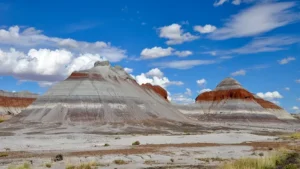
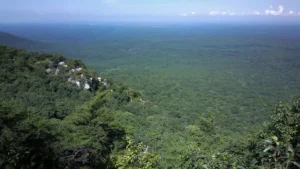
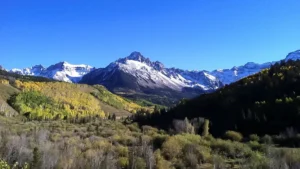

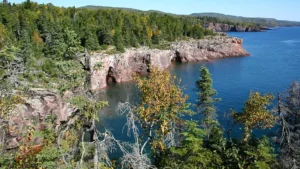
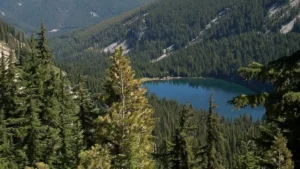

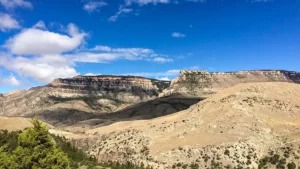


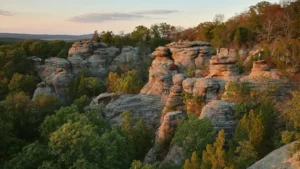
Leave your comment